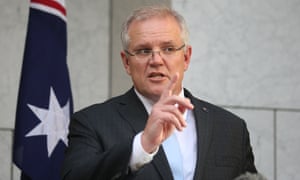The RBA begged the government for stimulus to kickstart the economy – to no avail. But coronavirus has seen a radical change in thinking
On 12 March Scott Morrison came to his courtyard with $17.6bn. A week later the Reserve Bank of Australia cut the cash rate to 0.25% and pumped more than $100bn into the financial system in an effort to keep struggling businesses afloat and stave off substantial job losses.
On 22 March Morrison returned to his courtyard with another $66bn. Then on 30 March, Monday, the prime minister came back with $130bn for wage subsidies. Monday’s $130bn will be spent not over the four-year forward estimates, which is the budgetary convention. It will be spent over the next six months.
This kind of investment is staggering – bigger than the annual health and education budgets combined.
We are losing a sense of the scale of these interventions because they are coming so thick and fast, the billions cascading into one another. But this is truly staggering.
The shapeshift of this particular Coalition government is also staggering.
When the Reserve Bank spent months last year trying to persuade this government to unleash some stimulus to help the sputtering pre-pandemic economy, Morrison and the treasurer Josh Frydenberg said, repeatedly, talk to the hand. We’ve gone from “only panic merchants do stimulus” to $130bn flying out the door in six months, few questions asked.On 22 March Morrison returned to his courtyard with another $66bn. Then on 30 March, Monday, the prime minister came back with $130bn for wage subsidies. Monday’s $130bn will be spent not over the four-year forward estimates, which is the budgetary convention. It will be spent over the next six months.
This kind of investment is staggering – bigger than the annual health and education budgets combined.
We are losing a sense of the scale of these interventions because they are coming so thick and fast, the billions cascading into one another. But this is truly staggering.
The shapeshift of this particular Coalition government is also staggering.
You’d say the current behaviour displays all the zeal of the convert, and that observation would be entirely true and valid, except it doesn’t really deliver the required insight.
Morrison made it clear on Monday why the government was acting, and acting on this scale. Events demand a new rulebook. We are all on the brink, Australia, and the rest of the world, and this Covid-19 pandemic has put us there.
The only thing that stands between all of us and the worst-case scenario is continued physical distancing, and massive fiscal firepower.
“Many countries in the months ahead and perhaps beyond that may well see their economies collapse,” the prime minister warned reporters. “Some may see them hollow out in the very worst of circumstances, we could see countries themselves fall into chaos”. The prime minister insisted Australia would be different. “This will not be Australia.”
The government did not want to go down the path of wage subsidies initially. It resisted the idea. But with Australia’s two most populous states pulling inexorably in the direction of lockdowns, with employers screaming for help, and job losses mounting everyday, wage subsidies is where the centre of gravity ultimately rested.
Over the past week or so, Morrison has begun framing his conceptual task. He wants to put the economy to sleep for six months. In preparing for that end point, he wants to make sure as many people as possible remain connected to their livelihoods to try and prevent unemployment carnage on the other side.
"How deep is this fiscal hole and how do we begin to recover? Honestly, who knows, and right now that is the least of our problems."
If people can remain connected to their jobs, and if businesses can hibernate and return in the spring with as few accumulated liabilities as possible, then the economic damage associated with this event is more likely transient than permanent.
This is the working theory in any case, and it is sound as far as it goes.
The main problem is nobody knows whether the pandemic will conform to the arbitrary six-month timeframe the government is currently putting on it both for fiscal reasons and to try and manage the country through the various transitions of the crisis without creating panic.
Will Morrison be back here in another six months, with another $130bn?
How deep is this fiscal hole and how do we begin to recover in a budgetary sense after this shock? Honestly, who knows, and right now that is the least of our problems.
Business has largely welcomed Monday’s wage subsidy announcement, while reserving the right to nitpick as the proposal is turned into legislation over the coming week or so. There will be nitpicking, sure as night follows day.
From the point of view of employees, this will obviously be comfort.
But there are questions.
Casual workers need to have been working regularly for same employer for 12 months or more to qualify for the new wage subsidy. How many casual workers will be in this position? Some will of course, but I suspect many casuals won’t, given the nature of casual work. New Zealanders in Australia are eligible for help but other workers on temporary visas aren’t. These poor people remain in limbo, at risk of destitution.
This scheme does give Australian workers a shot of seeing out this crisis while still remaining connected to their employers. That’s sound policy-making.
But there are no guarantees of what will happen after this pandemic passes. There is no guarantee employers will emerge from this crisis and roll back into business as usual, with their workforces intact, without skipping a beat.
In fact there is only one thing we can guarantee about this crisis.
There are no guarantees.

No comments:
Post a Comment